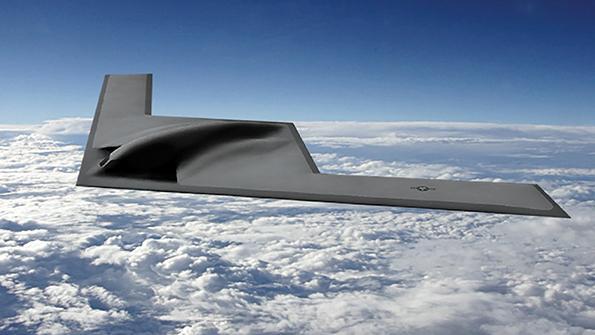Weekly Debrief: Clarity Eludes USAF Bomber Plan As ‘Arsenal Plane’ Re-enters Discussion

One number associated with the F-35 program has never changed, and it happens to involve the U.S. Air Force.
When Lockheed Martin received the contract in 2001, the Air Force’s requirement for F-35As stood at 1,763 aircraft and—although the justification seems increasingly brittle—so it remains nearly 19 years later.
Such consistency from Air Force leadership has not migrated to the bomber fleet. Until early 2018, official policy called for operating 80-100 B-21s with the existing fleet of B-1Bs, B-2s and B-52s indefinitely. Then, the Air Force released the “Bomber Vector,” which called for retiring the B-2s and B-1Bs as B-21s arrived, leaving B-52s as the only enduring aircraft from the current fleet. The “Air Force We Need” plan released in September 2018 reset the calculation again, with leadership now calling for a “minimum” of 100 B-21s to operate alongside 75 re-engined B-52s.
But the number has changed once again, and this time it comes in a way that reopens questions about the future composition of the fleet.
In retrospect, the new number for the Air Force’s objective bomber fleet quantity was revealed carefully. Last September, Gen. David Goldfein addressed the annual convention of the Air Force Association. In his speech, Goldfein reiterated the Air Force requirement to field a total of 175 bombers, but noted that “ideally” the actual number should be 220. The Air Force adopted no funded path to increasing the overall fleet by 45 aircraft, but set it as a goal.
Gen. Timothy Ray, the head of Global Strike Command, went even further during a teleconference with reporters in early April, saying the 220-bomber objective should be regarded as a minimum, not a ceiling.
“We know that the requirement for long range bombers is north of 220. In the past, we said it was 175, but that was a programmatically-derived approach. We as the Air Force now believe it’s over 220,” Ray said.
The Air Force has committed to operate 75 B-52s and 100 B-21s beyond 2050. With the B-52 out of production for 60 years, the easiest way to add more than 45 aircraft to the bomber fleet would be to increase the number of B-21s. But Ray would not commit to the obvious route.
“I think you can look at multiple paths. I believe we’re probably four or five years from being able to talk what that plan looks like specifically,” Ray said.
Another available option is to continue flying B-2s or a subset of the B-1B fleet beyond their planned retirements in the 2030s. Ray offered yet another approach: A new aircraft development program.
“You want to look for those opportunities to add capacity where you can,” Ray said. “My preference is to entertain something that can have more long range strike that’s more rapidly available.”
The Air Force has dabbled with the Arsenal Plane concept for decades. It is a concept that splits the difference between a large airlifter and a bomber. Such an aircraft would be highly vulnerable, so it would be limited to operating far from an enemy’s air defenses. But each aircraft would carry dozens of long-range cruise missiles, which would be dispensed like a C-17 drops large pallets of cargo. Indeed, the Air Force Research Laboratory (AFRL) experimented earlier this year with C-17s dropping palletized loads of munitions.
The concept offers Air Force policy makers an intriguing choice between an expensive platform, such as a B-21, with inexpensive, short-range munitions, or a cheaper platform, such as the Arsenal Plane, carrying costlier standoff cruise missiles.
The debate is not likely to be resolved in the near-term. Even if Air Force leaders coalesced around a plan to buy more B-21s or launch a new Arsenal Plane, the budgetary resources for the foreseeable future do not support either concept.
“Do we have enough budget to put something like that in right now? I don’t think that we do,” Will Roper, assistant secretary of the Air Force for acquisition, told reporters on May 14. “I think we’re pretty limited with the nuclear [modernization], Space Force stand-up, as well as all of the modernization programs that we have to get ready for China and Russia fights.”

Comments